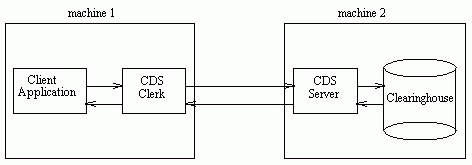What Is CDS?
The DCE Cell Directory Service is made up of several components, including the CDS server, CDS clerk, and CDS administration programs.
· CDS server
The CDS server runs on a node containing a database of directory information. It responds to queries from clients by accessing the database. (A CDS database is called a clearinghouse.)
· CDS clerk
The CDS clerk runs on the client node and serves as an intermediary between client applications and CDS servers. One of the clerk's most important functions is to maintain a cache of information acquired through directory queries. The clerk stores the response to a query in its cache so that the next time a related query is made, the information is already available on the client node, and no network communications with the CDS server are necessary. The cache is written to disk periodically, so it persists even if the clerk process dies or the client node crashes.
· CDS administration programs
Administrators can use the DCE control program dcecp to carry out the majority of CDS administrative tasks. There are also two administrative programs included in the CDS technology: the CDS browser and the CDS control program. The CDS browser, which end users as well as CDS administrators can use, is a CDS client application that allows you to inspect the cell's namespace. The CDS control program, cdscp, enables administrators to control CDS servers and data.
The following figure shows a client application that sends a request to the CDS clerk, which in turn communicates with the CDS server. The server performs a database lookup or update, depending on the request. The response is then sent back to the client application.
CDS Client and Server Machines
